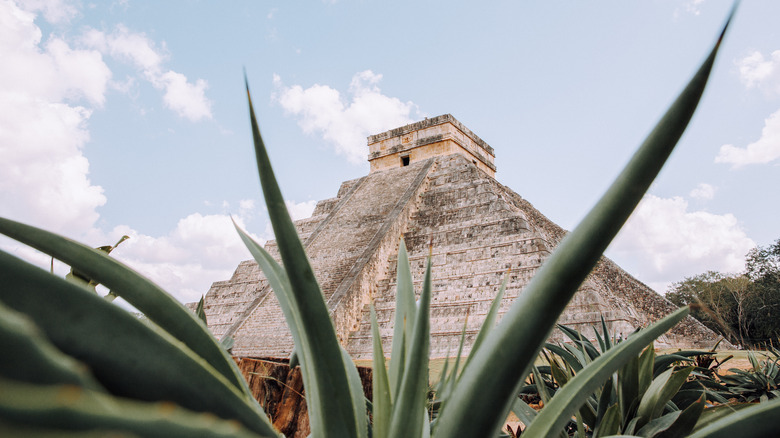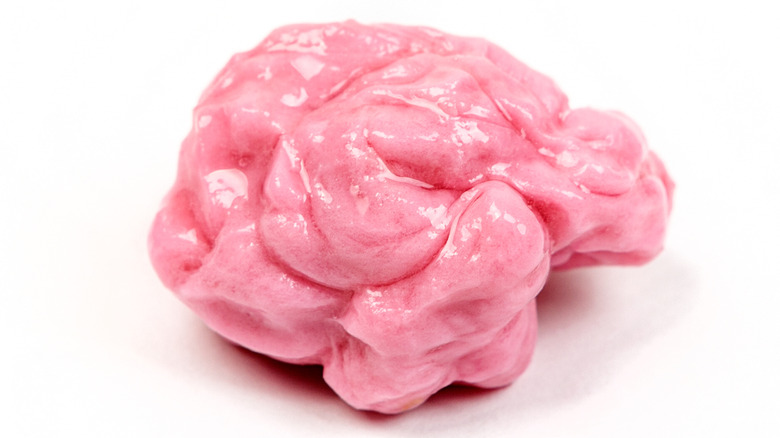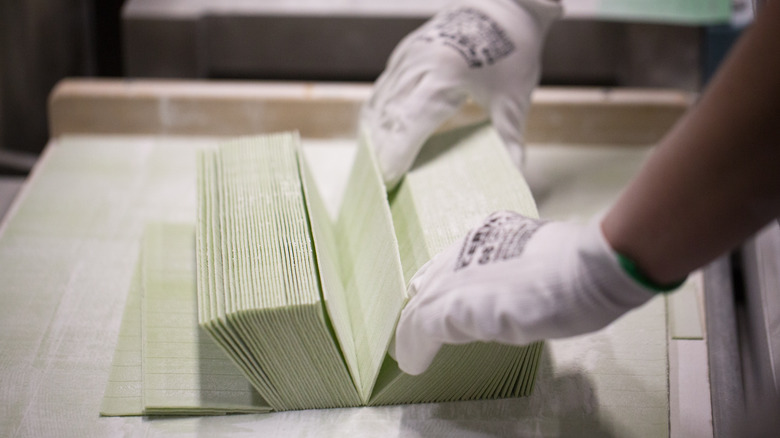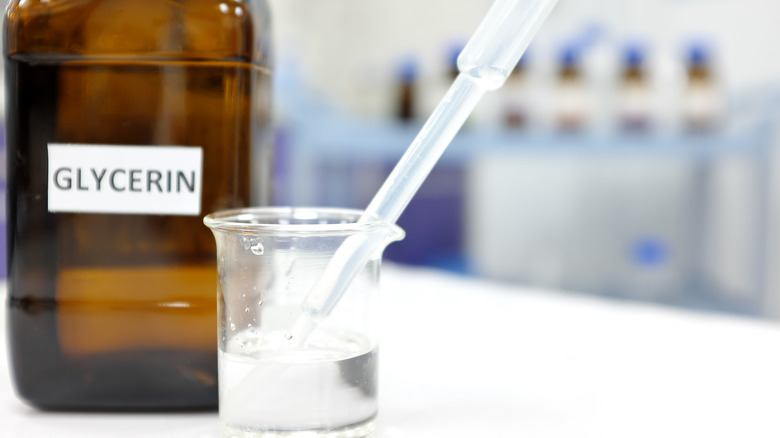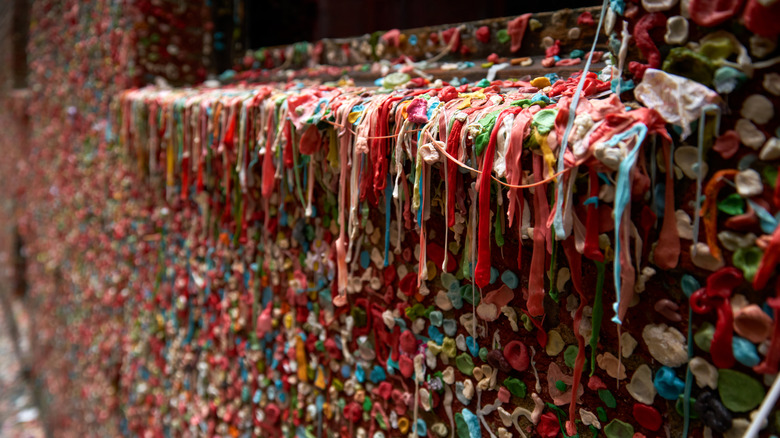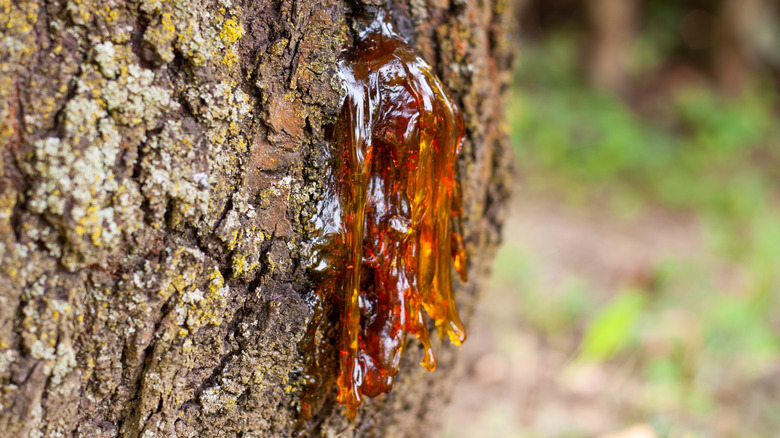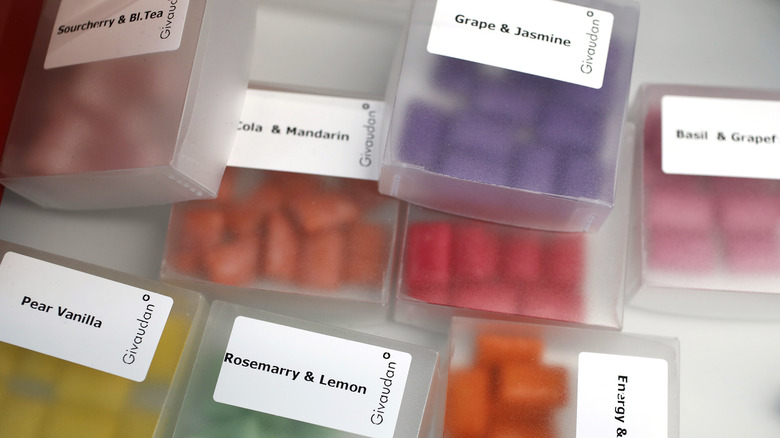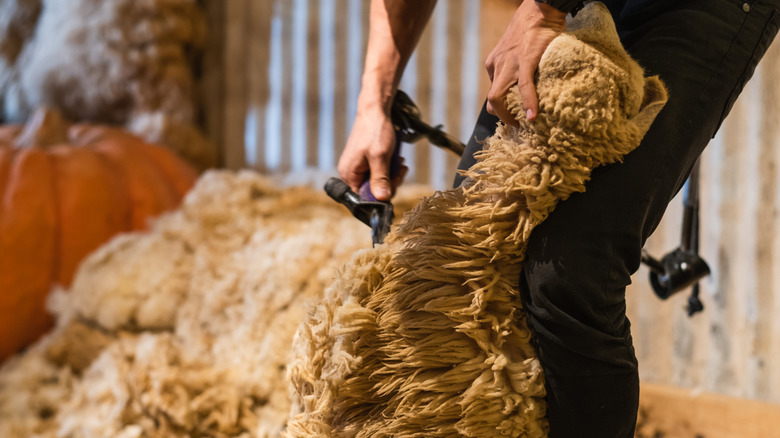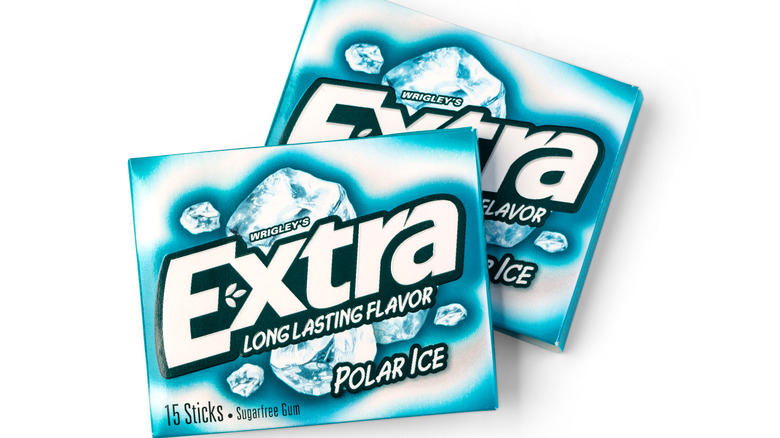This Is How Bubble Gum Is Really Made
Whether you love it or hate it, there's no denying that the sticky treat known as bubble gum is an iconic part of American culture. In, Statista reports that about 160 million Americans chewed gum in 2020 alone. From the 1978 film "Grease," which saw Frenchy blow enormous pink bubbles on the silver screen, to most major league baseball players, who chomp on the stuff whilst in the dugout, gum has been Americans' go-to candy for about as long as anyone can remember. Its popularity goes back even further. During World War I and World War II, gum had become such an integral part of daily life that every soldier received regular rations of gum while they were overseas (via National Archives). It's since become a popular culinary treat, including brands like Bubble Tape and Bubble Yum.
But have ever you ever wondered what ingredients are in the beloved confection? And how does it get transformed into those little sticks that are packaged and sold in most grocery and convenience stores? As it turns out, gum's appearance is deceptively simple, and there's actually a lot that goes into each and every piece of gum. This is how bubble gum is really made.
Gum has been around since the Stone Age
While gum, as we know it today, was developed during the 20th century, people have been chewing gum long before major gum brands hit the scene. Paleolithic people used birch pitch, a sticky substance that's made from heating the bark of birch trees, hundreds of thousands of years ago to affix stone blades to handles (via National Geographic). At some point, they discovered they could chew pitch to soften it beforehand, as archaeologists have found remnants of pitch with human teeth marks at ancient toolmaking sites. Recently, researchers have begun to utilize this gnawed-upon birch pitch as a source of genetic data to learn more about ancient peoples (via CNN).
Gum chewing has been utilized by multiple cultures and for a variety of purposes for thousands of years. Archaeological evidence suggests that ancient Europeans chewed birch bark 9,000 years ago for pleasure, while Mesoamericans also used it to alleviate tooth pain. The ancient Mayans and Aztecs chewed on a gum-like substance called chicle, a resin harvested from the sapodilla tree, according to Smithsonian Magazine. While the Mayans boiled the sap into "cha," which they chewed to satisfy both thirst and hunger pangs, the Aztecs used it to freshen their breath. Similarly, the ancient Greeks gnawed on a plant-derived substance called mastich, and Native Americans chewed spruce tree resin, which European settlers later picked up on and monetized.
Santa Anna brought gum to the United States
Antonio López de Santa Anna is probably best known as the Mexican general who waged a 13-day siege in 1836 at the Alamo in modern-day San Antonio, Texas. Ultimately, Mexico lost control of Texas during the Battle of San Jacinto a month later (via History). But even history buffs might be surprised to learn that Santa Anna helped introduce modern-day chewing gum to the U.S.
A disgraced politician, Santa Anna was forced into exile in the 1850s, during which time he drifted between Cuba, Colombia, and Jamaica, according to Atlas Obscura. He eventually traveled to New York City, where he hoped to raise money for an army so he could take Mexico City back. But it turned out to be a fool's errand. Eventually, the 74-year-old Santa Anna was living in a modest home in Staten Island after being swindled out of tens of thousands of pesos.
Santa Anna brought chicle with him to the States because chewing sap from sapodilla trees was common in his homeland. In a get-rich-quick scheme that he hoped would finance his return to power, Santa Anna propositioned a local inventor, Thomas Adams, to develop chicle into a rubber substitute (via NPR). Adams sunk $30,000 into this failed experiment, while Santa Anna eventually lost interest and left the project. Later, Adams added flavorings and sweeteners to the mix and launched a successful chicle gum company, per Atlas Obscura.
Modern gum is basically rubber and plastic
According to How Stuff Works, chicle-based chewing gum was the norm until World War II. As chicle became more expensive and less available, chemists began to swap it with artificial bases derived from synthetic rubber compounds. Few modern gum companies use natural chicle anymore.
Today, most major gum brands list "gum base" as one of their main ingredients, and while gum companies aren't required to disclose specifics — in fact, the ingredients are proprietary secrets — gum bases may include a cocktail of any number of FDA-approved additives (via the U.S. Food & Drug Administration). Oftentimes, one of the main ingredients in modern-day gum is polyisobutylene, also known as butyl rubber, the same material used to manufacture inner tubes (via Science Focus).
If the idea of chewing on rubber turns your stomach, you're not alone. The Economist reported that younger generations have little interest in chewing or popping bubble gum because of its unsustainable ingredients. In fact, gum sales plummeted by 14 percent in 2020 compared to the previous year. It's no wonder why since there is no law that requires gum to include an expiration date because the product is so shelf-stable, Serious Eats reported.
What makes gum ... gum?
The secret to gum's distinctive chewy texture lies precisely in its plastic and rubber ingredients found in the gum base. The gum base also includes elastomers for increased flexibility, which helps users blow bubbles. Although bubble gum is designed to be extra stretchy compared to the average stick of gum, you'll blow the biggest bubbles if you wait until all the flavor has disappeared. That's because sugar molecules weaken the bubble (via Science World).
According to Treehugger, talc and calcium carbonate are used to give gum its characteristic density. Meanwhile, softeners like vegetable oil are employed to make sure gum stays pliable.
In addition to the gum base, a myriad of other ingredients are mixed in to make gum a sweet-tasting treat. Without substances like artificial colors, preservatives, and sugar, the experience of chewing on gum would be a lot like chewing on a rubber band — flavorless and elastic (via Treehugger). Aside from sugar, popular artificial sweeteners for gum include xylitol, sucralose, and sorbitol.
Arguably, the most important part about gum all comes down to its taste. Manufacturers flavor gum using both natural and artificial ingredients (via Mental Floss). Although gum was originally flavorless, there is no shortage of gum flavors today, from peppermint and watermelon to cinnamon and citrus.
Manufacturing bubble gum is pretty complicated
The exact ingredients in gum might be a secret, but the process to make it is public knowledge and relatively standard across the industry. Although the process varies depending on the type of gum being produced, gum manufacturing is generally divided into three categories: mixing, shaping, then cooling and wrapping the final sweetened, chewy product (via Confectionery Production).
The steps necessary to mass-produce gum are reminiscent of Willy Wonka. According to Business Insider, production begins with the gum base, which is dumped into an enormous mixer. Then, colorings and flavoring agents are added, followed by liquid and powdered sweeteners and softeners. The ingredients are blended for about 20 minutes until melted by the friction of the stirring.
When the gum is mixed, it bears an uncanny resemblance to the giant pink creature from the 1958 horror film The Blob. Then, it's carted away to a machine called the pre-extruder. This squirts the gum through a tiny opening that transforms the colossal loaf into thin ribbons. Each strip is compressed into the thickness of a piece of bubble gum. Since this process heats up the gum, it's next transferred into the cooling chamber and blasted with cold air for 15 minutes. When the gum comes out, another machine cuts the strip into bite-sized pieces and then wraps each into its packaging in seconds.
You can potentially make gum at home
Here's a thought to chew on: Gum doesn't require massive fancy machinery or factory workers. With just a few simple ingredients and some technical know-how, anyone can whip up a batch of homemade gum in the comfort of their own kitchen. Even though gum is cheap and easy to come by, making your own gum can be a fun at-home experiment to test out interesting flavors like rosewater, lemongrass, cinnamon, and more. The possibilities are practically endless.
According to Science World, individual recipes may vary, but for the most part, the ingredients are more or less the same. They require a gum base, citric acid, corn syrup, and icing sugar. Most recipes will also call for glycerin or flavorings to taste. First, you'll mix the ingredients together and then melt the gum base in a double boiler or a microwave until it's very sticky and gooey. After the mixture cools, you'll add flavorings and colorings to the gum base, mix, and then knead the gum base for about 15 or 20 minutes. This last step is important, as it makes sure the gum doesn't fall apart as it's chewed. Finally, you'll cut the strip into bite-sized pieces and wrap each piece in wax paper, candy foil, or parchment before storing it in a plastic bag.
Gum can have a serious impact on the environment
If you've ever stepped on a wad of gum while walking down the street, then you've probably already realized that gum isn't biodegradable (via HuffPost). Since gum is now often made from synthetic plastics and rubbers, it doesn't break down in the environment. The exception to this rule is chicle-based gum made from natural materials.
Even though there's no denying gum is deliciously sweet, its ingredients mean gum has a sticky impact on the environment. In fact, there's a spot in Seattle called the Seattle Gum Wall where people travel from all over the world to walk through an alley decorated with pieces of chewed gum. While this might seem like a harmless tourist attraction, city officials elsewhere disagree. In fact, in New York City, so-called "GumBusters" regularly clean the city streets of discarded gum, per The New York Times. In Singapore, gum was banned in 1992 by Prime Minister Lee Kuan Yew after the sticky menace clogged subway doors, walls, and streets (via The Guardian).
There is a silver lining, however. As consumers have taken strikes to buy more responsibly, more companies are making products that are plant-based and biodegradable compared to "traditional" gum options. If you can't part with more mainstream labels like Wrigley's and Trident, you can at least carefully wrap and dispose of every piece of gum to help ensure sidewalks stay clean of gum litter.
Chicleros carry on the tradition of natural gum
As gum popularity soared in the U.S., demand wore down the Central American rainforests, where sapodilla trees are found (via Smithsonian Magazine). Sapodilla trees aren't ideal for mass production, but demand was unyielding. Farmers turned to unsustainable harvesting methods, resulting in the loss of about a quarter of the sapodilla trees in Mexico by the 1930s.
Synthetic ingredients have since eased the pressure, but some gum companies still use this natural and very sticky ingredient. As the Sierra Club reports, skilled laborers called chicleros trek into secluded areas of the wilderness, looking for chicle trees. Then, they shimmy up the trunk and make a series of swift, diagonal cuts to the bark with a machete. The white sap seeps out and runs down the tree through grooves cut with the machete, collecting at the bottom of the tree in a bag. At the end of the day, chicleros go back and collect the sacks.
A bonus of chicle-based gum is that it's biodegradable, helps to preserve the rainforest when it's harvested sustainably, and provides a potentially serious source of income for local populations (via The Guardian).
Why bubble gum flavors don't last long
While no one has quite figured out yet how to recreate the 3-course-dinner gum recipe of Willy Wonka fame, gum manufacturers are constantly looking for new ways to make gum flavors last longer. About 66 percent of gum chewers don't feel like the flavor in gum lasts long enough (via The New York Times). All told, most gum flavors today last a pretty paltry five minutes.
In Japan, scientists have been hard at work developing "electric gum" that holds on to flavor for far longer (via Digital Trends). Basically, researchers are able to simulate flavor with electricity as people chew on specially engineered gum. Although testers compared the flavor of the prototype gum to salty dried sardines, this breakthrough technology could still shake up the $32 billion global gum industry.
But why does gum flavor disappear, anyway? According to the American Chemistry Society, as you chew, your saliva dissolves the sweeteners and flavorings on your tongue, which you then swallow. However, saliva doesn't cause the gum itself to break down, which is why the flavor fades, but the chewy base stays.
There may be a gross ingredient lurking in your gum
Sorry to burst your bubble, but gum isn't just bright colors and sweet flavors. Sometimes gum is made with an ingredient called lanolin, the oily secretion sheep produce to help waterproof their wool. After sheep are sheared, the raw wool is processed and put through a centrifuge that extracts the lanolin (via Healthline). According to Science Direct, lanolin is similar to sebum, or the skin oil that humans naturally produce, and is made up of 170 fatty acids.
But why the heck would bubble gum brands put sheep sebum in something people eat? These oily secretions are commonly found in beauty products, from skin and hair care to makeup, where they're used as emollients to soften skin and retain its moisture. As it turns out, lanolin performs a similar function in gum. Ultimately, it is there so that gum doesn't harden as it's chewed.
Naturally, you may be now wondering if it's safe to consume what is essentially sheep grease. The answer is "mostly yes" since gum only uses a tiny amount. Lanolin is also approved for use in food products by the FDA, although experts caution against lanolin oil poisoning, which can rarely happen if someone swallows too much, according to Healthline. People who are allergic or sensitive to wool may also want to steer clear of many bubble gum brands, just to be safe.
Gum doesn't stay inside you for years
Melissa McCarthy once elicited a chorus of laughter for her impression of then-White House press secretary Sean Spicer on "Saturday Night Live," particularly his habit of swallowing whole packs of gum each day (via Vox). This brought on the age-old question: Is it safe to swallow gum?
An old wives' tale many people grew up hearing is that it takes a staggering seven years to digest gum. But it turns out that this is just a myth. Although swallowed gum isn't digestible, it doesn't possess any special properties that get it stuck in your stomach or other parts of your digestive system. Gum moves its way through your gastrointestinal tract relatively intact until it exits your body. In fact, swallowed gum generally doesn't stay in one's body for more than seven days, much less seven years, as Scientific American reports.
But even if gum doesn't linger in your digestive system, that doesn't mean it's entirely risk-free, especially when it comes to children. In 1998, the journal Pediatrics reported three cases of children who swallowed gum that formed a lump of undigested material in their gastrointestinal tracts. Side effects included constipation and some seriously expensive medical procedures, though all three kids survived.
For adults, gum swallowing seems to be mostly safe, but natural or artificial sweeteners that are used in sugar-free gums can lead to nasty symptoms if you regularly swallow the stuff, such as severe diarrhea and dangerous weight loss (via WIRED).
Recycled chewing gum is on the rise
Unfortunately, most gum winds up on the sidewalk or stuck to the bottom of people's shoes. Only an estimated 10 to 20 percent of all chewing gum is disposed of properly. In fact, gum generates about 100,000 tons of pollution yearly, and some local governments spend millions of dollars a year scraping up hardened wads of gum from city streets (via Fast Company). Some airports don't sell gum, Singapore requires a prescription for the stuff, and Disney theme parks don't sell gum, all to save on cleanup costs. But what if chewed gum could be given a second chance at life and turned into something useful that wouldn't tarnish the environment?
That's exactly what some innovative entrepreneurs are trying to accomplish. One British designer has developed a way to recycle chewing gum into moldable plastic, which in turn makes it so gum can be reused into new products, including coffee cups and sneakers (via The Verge).
In France, dezeen reports that design students have figured out how to turn used gum into brightly colored, recycled plastic skateboard wheels. They installed collection boards throughout urban areas for pedestrians to dispose of gum rather than discarding them to the streets.

